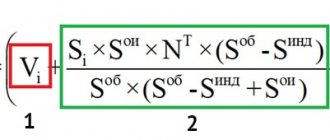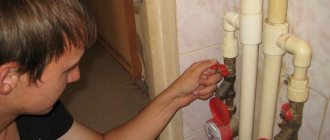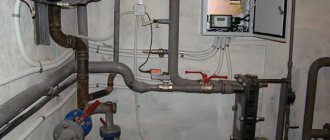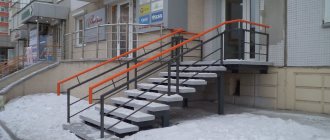Purpose of a common house heating meter
After the Housing Code determined that the common property of an apartment building is the property of the residents, their area of responsibility expanded significantly. Responsibilities for the maintenance and servicing of common property fell on the shoulders of apartment owners.
Since it is impossible to refuse to pay for general house needs, it makes sense to reduce the cost of heating residential and non-residential premises and pay only for the heat actually received.
To measure the amount of energy consumed, a common house heat metering device (CDMU) is installed. By paying for heating in an apartment building by meter, you will be able to control energy consumption and keep track of expenses. This is not the only purpose of installing ODPU.
Another goal pursued by the management company is to encourage residents to save heat outside their own apartments and take care of common property.
If the doors and windows in the entrance are tightly closed, the heat will be retained, and residents will receive the service in full.
It should be immediately mentioned that ODPU itself does not save anything. This is just a metering device that provides more accurate data for determining the final amount of payment for heating than the standards.
Is it possible to save money on heating at all?
From the above information we can conclude that a common house meter does not provide obvious benefits for residents. However, there are ways that will help you save money - these are individual heat meters installed in conjunction with thermostatic control devices for heating radiators.
Having such a device, you can independently control and regulate the heat supplied to the premises. In addition, if metering and temperature control devices are installed in all apartments of the house, this will allow their owners to be less dependent on each other.
- An individual metering device is mounted at the entrance of the heating pipes to the apartment. The meter must be sealed by representatives of the organization controlling the heat supply, otherwise its readings will be considered invalid.
- Thermostatic regulators are installed at the heating radiator inputs. A simplified option is chokes (regular or specially designed valves). thermostats. Of course, they are more expensive, but they make it easier to accurately regulate the temperature of each radiator individually. Thus, you can achieve a comfortable temperature in the rooms and not suffer from the heat by opening the windows when it’s +10÷15 degrees outside, and utilities are heated as if at -20˚C.
The best option is digital or mechanical thermostats. The thermostat head is installed so that it does not end up in the flow of hot air rising from the heating device. A special bellows device (expanding or decreasing in volume as the air temperature in the room changes) acts on the thermal valve rod, which reduces or increases the cross-section of the coolant passage into the radiator.
As mentioned above, if radiators are connected to different heating risers, then metering devices will have to be installed on each riser. And it is absolutely not a fact that they will be able to pay for themselves, since, in addition to the purchase, you will have to spend money on their maintenance, testing and possible periodic repairs.
There is another way to measure the heat spent on heating an apartment - an electric thermometer, which takes and records temperature readings from the surface of the radiator, as well as the air in the room. Such a device has a very affordable price, and it is not difficult to install it yourself - it is attached directly to the surface of the battery.
But such a device will in no way affect the payment for consumed heat - its readings have informational, but not official registration value. Having information about the operation of an individual radiator for a certain period, as well as about the total costs of all radiators, you can only roughly estimate the costs of heat for the entire apartment. This factor will be a good incentive to save money or find a “weak spot” in the thermal insulation system in order to eliminate the emerging heat leakage path. Thanks to this, overall heating costs can be significantly reduced.
But this increasingly applies to private houses or individual heating systems in apartments.
Installing a communal heat meter is legal
People first started talking about public meters back in 2009, when Federal Law No. 261-FZ “On Energy Saving and Increasing Energy Efficiency” was published. In the original version, the law prescribed the mandatory installation of ODPU in multi-storey buildings before January 1, 2012. Later this period was extended several times.
The last change in the period until January 1, 2019 and until January 1, 2021 (for Crimea and Sevastopol) was fixed on July 26, 2017.
Thus, the law on communal heating meters clearly confirms the need for their installation in apartment buildings. An exception is allowed only for dilapidated, unsafe and subject to demolition houses, as well as objects where installing a meter is technically impossible due to the non-compliance of the parameters of the utility network with the installation conditions of the device.
Central building heat meter, who should install it?
According to the recently adopted law, building-wide heat meters will soon appear in every apartment building. According to the law, it will be necessary to install metering devices in every high-rise building. It is extremely rare that such meters will not be installed in those houses where the building is located in a dangerous condition.
Naturally, residents have a lot of questions and often they indignantly ask questions, but who should install a common house heat meter today?
Who should install the meter?
This question is so neat, but it still has an answer. If we consider a specific clause of housing legislation, we can guess that the meter is a common property of the house. Based on this, it will be necessary to install it at the expense of the owners of the housing space.
The second paragraph of the housing code says that costs should be divided evenly by the area of the premises, which the tenant owns. Based on this, based on everything said above, one can guess that installing a common building meter is the responsibility of residents who use their own treasured square meters for their own purposes.
The Housing Code says that the obligation to install is still a privilege of the owners of the living space, which the owner is obliged to maintain on his own. In other words, the cost burden falls solely on the residents of high-rise buildings. Each owner, according to the marked share that he owns in the apartment building, will pay the costs of purchasing and installing a meter.
Motivation for energy saving
Some of us may indignantly ask, what are these counters for? The thing is that there are too many conversations going on right now about the importance of accumulating energy resources. Strict control of heat energy consumption becomes a responsible task for a given period of time that must be done. A common house metering device - stimulating the owners of living space to save resources as much as possible.
From here we conclude that a specialized law was adopted so that, in the end, payment for heat would be carried out as conscientiously and correctly as possible. Those residents who have invested (in the financial sense of the word) in preserving heat will receive smaller bills for heat than those owners who have a bad attitude towards resource consumption. For example, if the windows of a house are broken in the entrance, then it is cheaper and easier to install windows so as not to waste heat resources in vain.
Now the cost of a receipt for heat directly depends on the thriftiness of each resident. In fact, cash motivation is one of the most effective. The law makes it possible to control the volume and parameters of the coolant, which is also extremely important. Now the shared responsibility that lies on the shoulders of the residents will force them to close the entrance door, through which the expensive heat evaporates.
Circumstances will not occur as before this time, when residents shrugged it off and believed that someone else would close the door, because anyway there would be no need to pay for such inattention.
Installation procedure for a collective heat meter
If the centralized heat supply system has the technical ability to install a common house heat meter, it must be installed.
In newly built houses, energy meters are installed before the facility is put into operation. This requirement is contained in the law on the installation of a common house meter dated November 23, 2009 in paragraphs 7-8 of Article 11, and paragraph 9 of Article 13 defines the area of responsibility for installing a public meter in houses where it is not available.
In order for a common house meter to appear in your home, you must go through several stages of its installation procedure.
- A meeting of owners of an apartment building (MKD) is the basis for the installation of heat meters for heating in an apartment building.
- The meeting may be initiated by the Management Company. In HOAs, housing cooperatives, and residential complexes, the meeting is held on the basis of an application from the owners; 10% of the signatures of the total number of votes is sufficient.
- Technical conditions for the installation of an ODPU, in accordance with which its design and installation will be carried out, are issued by the heat supply organization.
- The installation project and the estimate for the work are prepared by the design organization, taking into account the specific installation location and indicating the device model.
- Coordination of the project with the heat supply organization that issued the technical specifications.
- Purchasing a project-approved ODPU, mandatory with a verification stamp.
- Installation of ODPU and putting the meter into operation.
Find out in more detail how to install communal metering devices in apartment buildings.
Organizations responsible for installing ODPU
According to Law No. 261-FZ, the responsibility for installing a collective heat meter is assigned to the owners of apartments in a multi-storey building, who must carry out this activity independently, choosing an equipment supplier and a contractor for the work.
Assuming that there will be houses that are not equipped with ODPU, legislators determined who should install heat meters in this case. So, if on July 1, 2012, houses did not have a heat meter, the responsibility for installing it was transferred to the resource supply organization (RSO).
In addition, the RSO is obliged to prepare proposals for equipping apartment buildings with metering devices and carry out the corresponding work, which is confirmed in the letter of the Federal Antimonopoly Service of Russia dated December 8, 2011 No. AG/45584.
Thus, the widespread information that the management company installs heating meters is erroneous. The task of the management company is only to:
- bring to the attention of the owners of apartments in apartment buildings the need to install a collective heat meter;
- organize a meeting;
- draw up a protocol of consent.
Activities for installing the device can be carried out by heat energy supply organizations or specialized companies that have:
- Qualified specialists on staff of the company.
- Permission to perform the relevant type of work, issued by SRO.
The procedure for registration and installation of the meter
So, in what sequence should the heating system of an apartment building be equipped with a meter if it was not installed immediately during construction?
The first step should be a house-wide meeting - it is most often organized by representatives of the management company. At the meeting, a decision is made to install a heat meter and the type of device is selected. Then representatives of the residents of the house or the management company contact an organization that has the appropriate authority and is engaged in the supply and installation of heat metering devices.
Further work is carried out in the following order:
- A project is being drawn up to integrate the meter into the heating system of the house.
- The management company, having studied the draft, gives its consent to the installation work.
- Next, in accordance with the project, the device is installed into the system.
- After this, it is mandatory to test the operation of the device with the preparation of documentation from the installer company.
- Finally, a representative from the heat supply company is called, who will seal the meter and draw up an act for its registration. And only after official registration the device becomes the basis for further calculations for the heat consumed by the house.
If all of the above measures are not carried out, and the meter is not officially registered, then its data will not be considered legitimate and will not be indicated in receipts for heating payments.
Some factors affecting the operation of the device
During the operation of the meter, the quality of its operation may be influenced by external factors, on which the accuracy of the readings sometimes depends.
The most common influencing factors today are:
- High coolant temperature can partially or completely damage the metering device. Although, it was originally designed for such operating conditions. But the quality sometimes lets you down.
- The formation of scale on the internal walls of the pipeline reduces the diameter of the pipe, and as a result, the passage of water flow becomes difficult. In this regard, some meters stop giving real readings - as a rule, they change upward.
- Failure to ground the pipeline leads to the formation of an electric charge inside the pipeline, which also causes errors in the meter readings.
- Contaminated coolant, as well as gas bubbles suspended in water, are a negative factor for all types of metering devices, as they affect the correctness of the readings. To eliminate errors, it is necessary to install protective filters in front of the meter.
- Pressure drops in the heating system can also distort the meter readings.
- Layering of sediment in the cavity of the device itself. In a tachometer meter, the presence of sediment reduces the readings, but in all others, on the contrary, it increases it.
- Electronic equipment malfunctions under the influence of high humidity and temperature changes in the room where the metering device is installed.
It should be noted that all of the above points - choosing a meter, monitoring its operation, as well as negative factors affecting the accuracy of its readings - affect each of the residents of the house, affecting the amounts payable. Therefore, after putting the heat meter into operation, all residents will have to be attentive to possible failures in the heating system, as they will most likely affect the meter readings. If problems arise, you must immediately call the service company’s specialists to carry out preventive maintenance.
And what even a temporary failure of metering devices can lead to is shown very clearly in the video we offer:
How much does a communal heating meter cost?
Since heat meters for heating, in accordance with Law No. 261-FZ, are the property of the residents of an apartment building and they bear all the costs of their purchase and installation, the issue of the cost of ODPU is very important. Let's look at what expense items make up the cost of installing a collective meter.
- Cost of the device. The price of a heat meter directly depends on its type and manufacturer. There are several types of heat meters:
- tachometer - the cheapest models (6-10 thousand rubles) with a service life of 2 to 4 years;
- vortex - a more expensive option, the average price of which is 15 thousand rubles;
- electromagnetic - costing 15-17 thousand rubles;
- ultrasonic - depending on the model, the price from the manufacturer ranges from 15,000 to 50,000 rubles.
- The cost of preparing a document containing the technical conditions of the heat supply system and developing design documentation for the equipment of the metering unit.
- The price of an additional set of equipment and related materials.
- Installation cost: installation, electrical installation, as well as commissioning.
All costs result in a fairly high amount: from 150 to 300 thousand rubles. This is what the residents of the house have to pay. You can do this in several ways:
- one-time payment (required for legal entities);
- installment payment, which is provided for a period of up to 60 months and is paid in equal installments. The interest rate depends on the refinancing rate set by the Central Bank.
- using funds from the overhaul fund, provided that this service is included in the list of works on overhaul of common property in the apartment building in the constituent entity of the Russian Federation, in accordance with the Housing Code of the Russian Federation (Part 2 of Article 166).
The payment mechanism is regulated by law: the amount is distributed among all apartment owners depending on the area of housing and the timing of deposits.
How much does a communal heat meter cost?
If everything is more or less clear with individual metering devices for consumed utility resources, then the question of why it is necessary to purchase a common house heat meter is doubtful for most.
Heat supply is generally the most expense item in receipts for housing and communal services. And the necessary services do not even think about lowering tariffs; on the contrary, the fees only increase every year. And actually, thanks to common house metering devices, it was possible to achieve a fair distribution of payments for heat in apartment buildings, and this is taking into account that the price of a common house heat meter is very high.
Often, residents shift responsibility for their general well-being to one another and to housing and communal services employees, being careless with their access or home property. For example, someone may break the glass in the entrance and not want to replace it. And in winter, expensive heat goes away, taking with it the money spent on heating the house. The installation of a common house meter will help awaken consciousness in each resident of a building with several apartments, force them to close windows, insulate apartments and treat public property much more carefully, taking into account how much a heat meter costs.
The main disadvantage of this approach is that residents will have to pay for the installation of the device out of their own pocket. Thanks to this, the question of how much a common house heat meter costs worries many conscientious citizens. So how much does a common house heat meter cost? The average price is 150 thousand rubles. In this case, residents of large multi-entrance houses find themselves in a much advantageous position. But in general, the purchase will reduce the price of heating by 3% within a month and will pay off in approximately three years.
The cost for a common house meter starts from 150 thousand rubles and above. Naturally, everything can depend on many factors: pipe diameter, number of required flow meters, number of apartments/floors. Taking into account weather regulation or without. Everything is personal.
In certain houses, heat is divided unequally; those with slightly warm radiators will probably perceive information about how much a heat meter costs with poor quality. If the residents of your house are also affected by this problem, you will be able to improve the wiring along with installing the meter. Professionals from your management company will tell you how to do this.
Do not trust the installation and sealing of meters to non-specialists, as this can lead to damage to the device itself, as well as to problems with payment and the legality of having the device in the house.
Only the joint and good work of all residents to save heat will help to avoid very large heat bills, and also, heat every living space in the house without high expenses.
Similar products:
Maintenance of common house heat metering devices
Maintenance of the meter involves maintaining it in working condition. This is achieved as a result of preventive work, such as:
- inspection and elimination of causes affecting wear and breakdown of the control and measuring unit;
- checking the operation of additional equipment;
- operational maintenance and control of metrological accuracy of measurements of the metering device;
- weekly readings for analysis and development of recommendations for maintaining the required temperature.
If a malfunction is detected during the inspection, the device is dismantled, the damage is repaired and reinstalled.
To get a complete picture of maintaining the ODPU in working condition, find out how the MKD heating system is maintained.
Reconciliation of readings from a common house heat meter
To calculate monthly payments, accurate and timely readings are needed, which are taken from the general building meter. In accordance with the Decree of the Government of the Russian Federation dated 06.05.11 No. 354, responsibility for heat metering lies with the utility service provider, which can be:
- Management Company;
- HOA;
- Housing cooperative;
- resource supply organization.
Meter readings are taken monthly from the 23rd to the 25th of the current month. The ODPU service agreement may contain a clause on the presence of a representative of the residents when readings are taken.
If there is no such condition, then, at the consumer’s request, the contractor is obliged, within one working day, to acquaint him with the instrument readings recorded in the ODPU reading log. This document is a kind of reporting to consumers and answers the question of how to check the readings of a common building heating meter.
Data storage period is 3 years. In cases where meter data is transmitted remotely in electronic form, the consumer has the right to request a screenshot of the readings recorded by the modem.
Calculation of heat energy consumption using a collective meter
Compared to the standards, the installation of ODPU provides more accurate accounting of thermal energy consumption. The calculation is based solely on meter readings, taking into account the difference between them at the end and beginning of the calculated period. This value is required to calculate the amount payable for heating.
The formula for calculating the cost of heating is as follows:
P = Qtot x S / Stot x T.
In other words, the volume of heat according to the meter (Qtotal) is multiplied by the area of the house (S), divided by the area of the apartment (Stotal) and multiplied by the tariff (T). (RUB/Gcal), approved by local governments for each region separately.
Find out more about how heating is calculated for an apartment.
Responsibility for lack of meters
The absence of ODPU is considered a violation of the law, which threatens the management company and the HOA with fines, and residents with an increased coefficient. Currently, this value is 1.6 of the heat supply tariff. The increasing factor does not apply to houses where it is not technically possible to install meters.
A resource-saving organization may be fined on several grounds:
- non-compliance with the requirements for submitting proposals for equipping apartment buildings with heat metering devices. The fine will be from 20 to 30 thousand rubles for officials and from 100 to 150 thousand for legal entities (clause 6 of article 9.16);
- Unreasonable refusal or evasion from concluding an agreement for the installation of ODPU and/or its execution is subject to a fine of 20-30 thousand rubles for officials and from 50 to 100 thousand for legal entities (Clause 12 of Article 9.16 of the Code of Administrative Offenses of the Russian Federation).
The management company can be fined for failure to comply with notification measures, because its function is to encourage residents to install a meter, justifying the need for this measure. The fine will range from 5 to 10 thousand rubles for officials and from 20 to 30 thousand for legal entities (clauses 4-5 of Article 9.16 of the Code of Administrative Offenses of the Russian Federation).
Read more about how the responsibility of the management company manifests itself.
Advantages and disadvantages
common house meter
When justifying the need to install ODPU, the Criminal Code usually gives the following arguments:
- payment for actually consumed heat energy. The presence of a meter allows you to accurately monitor heat consumption and reduce heat energy costs by up to 30%;
- recording leaks in the heating system in order to prevent overpayments for water losses from the central pipeline to the house;
- increasing responsibility for the common territory. By paying for losses from their own pockets, residents of the house are more attentive to the condition of the common property.
Along with the advantages, a heat meter for an apartment building also has disadvantages, which primarily relate to the financial burden on the owners of apartments in multi-apartment buildings. All costs associated with installation and repair of the meter are borne by the residents. The fewer apartments in the building, the higher the payments.
Individual heat meters
Installation of an individual heat meter is not necessary. It is installed at the request of the apartment owner, as stated in the Decree of the Government of the Russian Federation dated 05/06/11 No. 354 (clause 3, article 33, section V).
According to the Order of the Ministry of Regional Development dated December 29, 2011 No. 627, individual meters are prohibited from being installed in apartments with vertical wiring.
In addition, in order for the calculations for heating to take into account the readings of apartment meters, they must be installed in each residential and non-residential premises of the apartment building along with a general heat energy meter.
More information about the types of individual heat meters and their purpose is contained in the material “Heat meters for heating in an apartment.”
Results
The Energy Saving Law obliges residents of apartment buildings to install common heat energy meters at their own expense, with the exception of houses that do not meet the technical capabilities.
Both the management company and the RSO take part in the ODPU installation procedure, with the first organizing, and the second being responsible for installing the device. In case of failure to fulfill their obligations, companies will be fined, and residents will receive a receipt for heating payment with an increasing coefficient. Time will tell how expedient the forced installation of collective meters is, but the effect of using ODPU is undeniable: heating costs are reduced by up to 30%.
Operating principle of a heat meter
The heat meter has a wide range of functionality. It allows you to determine the period of operation of devices, which is indicated on a specific metering unit. Also indicates the temperature of the coolant. But the main thing is to record the amount of heat energy consumed.
The heat meter circuit includes:
- Thermal converters – temperature sensors;
- Calculator – calculates the amount of heat spent;
- Power supplies;
- Flow meter is a sensor for calculating volume.
A heat meter is used to record the received heat that comes with the coolant. The amount of energy used by the device per hour is determined, and the temperature of the liquid at the inlet and outlet and into the system is taken into account. This is how the temperature difference over a certain time is determined. For this purpose, a special computer is provided in the meter.
The required data is supplied through flow and temperature sensors. One temperature sensor must be installed in the supply pipe of the system, and the second in the outgoing pipe. The computer analyzes the received data and displays the exact consumption figure on the screen.







